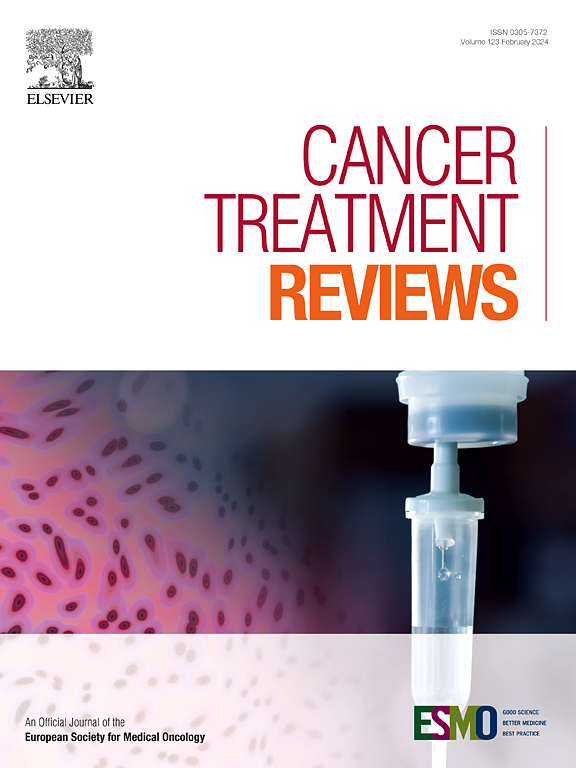促性腺激素释放激素激动剂治疗绝经前乳腺癌患者的不完全卵巢功能抑制。
IF 9.6
1区 医学
Q1 ONCOLOGY
引用次数: 0
摘要
背景:卵巢功能抑制(OFS)已成为绝经前乳腺癌患者的重要辅助治疗方法。一些患者使用常用的OFS药物不能达到完全的OFS。不完全OFS的定义仍然不明确,而且缺乏关于其发病率的大规模数据。本文就不完全OFS的定义、发生、对疗效的影响及相应的治疗措施进行综述。方法:以“卵巢功能逃逸”、“不完全OFS”、“雌激素突破”等关键词检索PubMed、Embase、Cochrane图书馆近二十年的数据库,对重要文献进行滚雪球式的查阅。对绝经前乳腺癌患者应用OFS治疗的临床文献进行筛选。提取不完全性OFS的患者特征、定义、发生率、预后、干预措施等信息。结果:共纳入17项研究,包括随机对照试验、回顾性或前瞻性队列研究和病例报告。文献表明,当雌二醇(E2)阈值设定为2.72 pg/mL、10 pg/mL、20 pg/mL或30 pg/mL时,不完全OFS的发生率约为5- 50%。年龄小、身体质量指数(BMI)高、无化疗史是不完全性OFS的危险因素。不完全OFS的治疗包括调整剂量、替代OFS药物或采用其他OFS措施。结论:不完全OFS率随治疗时间的延长而降低。对于存在不完全性OFS高危因素或同时使用芳香化酶抑制剂(AI)的患者,监测E2水平以确保OFS成功是合理的。短暂的不完全性OFS似乎对预后没有影响,但持续的不完全性OFS需要个性化调整治疗策略以确保完全的OFS。本文章由计算机程序翻译,如有差异,请以英文原文为准。
Incomplete ovarian function suppression in premenopausal breast cancer patients treated with gonadotropin-releasing hormone agonists
Background
Ovarian function suppression (OFS) has emerged as a crucial adjuvant therapy for premenopausal breast cancer patients. Some patients fail to achieve complete OFS with commonly used OFS drugs. The definition of incomplete OFS remains unclear, and large-scale data on its incidence are lacking. This review provides a comprehensive overview of the definition, occurrence, impact on therapeutic efficacy and corresponding treatment measures for incomplete OFS.
Methods
We searched PubMed, Embase and Cochrane Library databases in recent twenty years with keywords as “ovarian function escape”, “incomplete OFS” and “estrogen breakthrough”, and carried out a snowballing of references to important literature. Clinical literature of premenopausal breast cancer patients treated with OFS was screened. The patient characteristics, definition and incidence of incomplete OFS, prognosis, interventions and other information were extracted.
Results
A total of 17 studies were included in the analysis, including RCTs, retrospective or prospective cohort studies and case reports. Literature indicates that the incidence of incomplete OFS is around 5–50 % when the estradiol (E2) threshold is set as 2.72 pg/mL, 10 pg/mL, 20 pg/mL, or 30 pg/mL. Young age, high body mass index (BMI), and no prior chemotherapy were the risk factors for incomplete OFS. The treatment of incomplete OFS included dose adjustments, alternative OFS drugs, or the adoption of other OFS measures.
Conclusions
The incomplete OFS rate decreased with the extension of treatment time. It is reasonable to monitor E2 levels to ensure successful OFS in the patients with high risk factors for incomplete OFS or with concurrent use of aromatase inhibitor (AI). Transient incomplete OFS seems to have no impact on prognosis, but sustained incomplete OFS needs personalized adjustment of treatment strategy to ensure complete OFS.
求助全文
通过发布文献求助,成功后即可免费获取论文全文。
去求助
来源期刊

Cancer treatment reviews
医学-肿瘤学
CiteScore
21.40
自引率
0.80%
发文量
109
审稿时长
13 days
期刊介绍:
Cancer Treatment Reviews
Journal Overview:
International journal focused on developments in cancer treatment research
Publishes state-of-the-art, authoritative reviews to keep clinicians and researchers informed
Regular Sections in Each Issue:
Comments on Controversy
Tumor Reviews
Anti-tumor Treatments
New Drugs
Complications of Treatment
General and Supportive Care
Laboratory/Clinic Interface
Submission and Editorial System:
Online submission and editorial system for Cancer Treatment Reviews
 求助内容:
求助内容: 应助结果提醒方式:
应助结果提醒方式:


